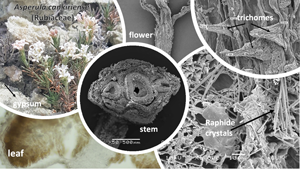Article contents
Notes on the Newly Identified Asperula cankiriense B. Şahin & Sağıroğlu (Rubiaceae) from Turkey Based on a Light and Scanning Electron Microscopic Study
Published online by Cambridge University Press: 09 February 2022
Abstract

Micromorphological features of vegetative and reproductive organs in plants are considered important because they can be used as taxonomic characters. Asperula cankiriense B. Şahin & Sağıroğlu, commonly known as “Çankırı belumu”, belongs to the family Rubiaceae and generally occurs in gypsum steppes. This research reports for the first time the micromorphological characteristics of the vegetative and reproductive organs of A. cankiriense using light and scanning electron microscopy. Taxonomically critical diagnostic features, such as raphide crystals, presence and shape of trichomes, leaf cross-section shape, flower structure, and epidermal ornamentation, were described in detail. This study provided up-to-date information on the micromorphology of this newly described species and provided additional systematic information on A. cankiriense. New data about the species are reported here and will contribute to the knowledge about the family Rubiaceae.
- Type
- Micrographia
- Information
- Copyright
- Copyright © The Author(s), 2022. Published by Cambridge University Press on behalf of the Microscopy Society of America
References
- 1
- Cited by



